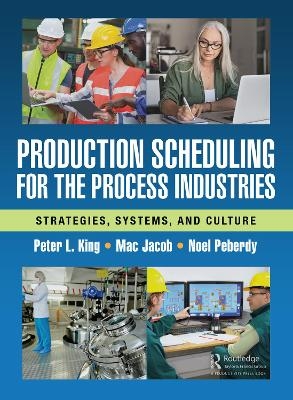
Production Scheduling for the Process Industries
Productivity Press (Verlag)
978-1-032-30236-2 (ISBN)
The book explains in detail that no scheduling strategy, and especially no transition to a different and better scheduling strategy, will succeed without strong commitment and guidance from senior leadership. Leadership must understand their active role in the transition, that people will feel uncomfortable and even threatened by change, and that they will need to be measured by different standards. Effective scheduling requires that following the schedule and production to plan is more important than trying to maximize each day’s throughput.
The book explains the advantages of a structured, regularly repeating schedule: how it can increase throughput, right-size inventory based on cycles and variabilities and therefore make it more usable, and improve customer delivery. It will explain the trade-offs between throughput, inventory, and delivery performance, how those trade-offs are actually decided in production scheduling, and how an appropriate scheduling strategy can make the trade-offs and their ramifications visible. It discusses several popular structured scheduling concepts, their similarities, and differences, to allow the readers to decide which might fit best in their environments.
In addition, the authors discuss what makes an appropriate scheduling software system, and why a package designed for structured scheduling offers capabilities well beyond the Excel workbooks used by many companies, and how it offers much more design capability and ease of use than the finite scheduling modules in SAP or Oracle.
Finally, the authors offer a proven roadmap for implementation, critical success factors necessary to achieve the full potential, and give examples of operations that have done this well. In addition, a guide for leaders and managers post-implementation is provided to help them fully exploit the advantages of a structured, repeating scheduling strategy.
Peter L. King, Mac Jacob, Noel Peberdy
SECTION 1 – Introduction Chapter 1 Business Imperatives – Why Scheduling Matters Chapter 2 Characteristics of Process Operations - and Scheduling Challenges Chapter 3 Overview of Production Strategies Chapter 4 Scheduling Processes d Software
Chapter 5 Example Process SECTION 2 – Scheduling Strategies Chapter 6 Repetitive Scheduling Strategies Chapter 7 Dealing With Disruption SECTION 3 – Scheduling Processes, Systems, Software Chapter 8 The role of Forecasting Chapter 9 The Role of Inventory Chapter 10 Typical Scheduling Process Steps Chapter 11 Multi-Level Scheduling Chapter 12 Tanks, Bins, and Flow Paths Chapter 13 The Role of ERP in Planning and Scheduling Chapter 14 Excel as a Finite Scheduling Tool Chapter 15 Software Designed for Production Scheduling Chapter 16 Critical Ingredients, Raw Materials, and Components Chapter 17 Scheduling Software - Security and Privacy SECTION 4 – Prerequisites to Good Scheduling Chapter 18 The Role of the Plant Leader Chapter 19 Scheduling Readiness Criteria Chapter 20 Accessible, Accurate, and Complete Data Chapter 21 Effective Production and Capacity Planning Chapter 22 Workforce Engagement Chapter 23 Changeover Reduction – SMED Chapter 24 Production Stability Chapter 25 Cellular Manufacturing Chapter 26 Managing Bottlenecks and Constraints Chapter 27 Leading Scheduling Improvements to Drive Value: Five Steps for Leaders Chapter 28 Where to Begin - A Roadmap to Project Success Chapter 29 Critical Success Factors Chapter 30 Success Stories – Examples Of Scheduling Best Practices
| Erscheinungsdatum | 17.07.2023 |
|---|---|
| Zusatzinfo | 85 Line drawings, color; 85 Illustrations, color |
| Verlagsort | London |
| Sprache | englisch |
| Maße | 210 x 280 mm |
| Gewicht | 571 g |
| Themenwelt | Technik ► Umwelttechnik / Biotechnologie |
| Wirtschaft ► Betriebswirtschaft / Management ► Logistik / Produktion | |
| Wirtschaft ► Volkswirtschaftslehre | |
| ISBN-10 | 1-032-30236-4 / 1032302364 |
| ISBN-13 | 978-1-032-30236-2 / 9781032302362 |
| Zustand | Neuware |
| Informationen gemäß Produktsicherheitsverordnung (GPSR) | |
| Haben Sie eine Frage zum Produkt? |
aus dem Bereich


